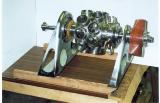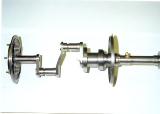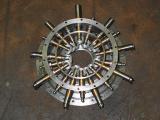Editorial
Today, Tuesday March 1 2005, is the first day of autumn here Downunder, in the Wide Brown Land. Sunday last was spent standing in a parched paddock with the temperature reaching as high as 41 degrees C (that's 105.8 F by the way) with nary a breath of air moving. There was no air movement because it was F1H State Champs day—F1H being the unintelligible FAI designation for what was once called A1 tow line glider—the 'small' ones. Such gliders need at least a breath of air to get them established on the tow, hence the totally predictable total lack of wind on a contest day. Net result is I'm just about dead and still wanting to know when the fun is scheduled to start (which you can interpret as coming a bad nowhere in the results  ). In two weeks time, it will be the big gliders turn (A2, or F1A if you will). These guys can go a long way quickly, but will tow easily in still air. Naturally, it will blow a gale and we'll walk miles with radio trackers to retrieve them...
). In two weeks time, it will be the big gliders turn (A2, or F1A if you will). These guys can go a long way quickly, but will tow easily in still air. Naturally, it will blow a gale and we'll walk miles with radio trackers to retrieve them...
Meanwhile, back at the web site: Oh look! The left hand Nav Bar is still unchanged... I do have a new version in my "sandbox", but something else pushed it off the front burner. This site is now moving. The new URL is http://staff.dstc.edu.au/chernich/ron. If you look there now, you should see something like an echo of what you are looking at using the old URL. But anything that generates dynamic results (the Engine Finder, the Site Search, the Engine Review filtering, etc) will not yet work because I have to adjust some relative path stuff and move scripts to cgibin etc. But by the end of March, it should hopefully all be cut over. The current URL will then turn into a "redirect" so your old bookmark to the front door will continue to work for a while (direct links to lower pages will no longer be guaranteed). The advantage is (i) the URL is a bit easier to type, but (ii) the host server has much more grunt, so site searches will be blindingly fast as compared with the current response time (and we'll go from an antiquated Perl 5.0 to 5.8 for the dynamic stuff, which also give some performance boost). DSTC, our host and beloved CRC is still under the shadow of death though, but we have 15 months yet until the doors must close (unless more funding can be found), so the web site will stay here a while longer yet, hopefully.
On Yet Another Totally un-model engineering related topic, I'm constantly amazed at the number of software developers who are ex-musicians (and in some cases, not so "ex" at all). Must be something to do with the mind-set. While searching for a copy of a jazz chord progression book I remember fondly from over 30 years ago, I blundered onto the web site of a company that produces an application called Band In A Box. This thing truly blew my little cotton socks off—not so much as a musician, but as a software developer! And how something at that level of sophistication and quality can be sold and supported for under $100 is a source of amazement (gotta give up metadata and get into mass-market appeal apps...) So if you have any interest in this area, by all means have a look at the link and sample some of the 'video' demonstrations.
And while off-topic, lately I've been forgetting to keep reminding the world that Microsoft CEO, Bill Gates, has promised the world a cure for email spam by February 2006. That means there's less than a year to go. Why do I not feel confident?
Back on topic: There were over 9,000 hits last month. I thought this month was going to be Slim Pickins, but it seems to have turned out not to be the case (again). In fact I'm sure I've forgotten to include a few things kind readers have alerted me to, but that I've lost in the confusion relating to the web site move. If I made you a rash promise and you don't see the result, please email me—I won't be in the least offended. Ok. Bad news first...
Vale: Bob Palmer
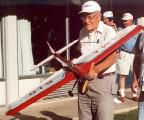
Sadly, I must report that Bob Palmer, one of the great names in aeromodelling, passed away on February 1, 2005. Bob is generally given credit for first fitting coupled flaps and elevators to control line stunters (the Go-Devil, circa 1949). He will be remembered for his Thunderbird and other designs, many of which were kitted by Veco—a company whose designs and engines are always associated with his name. The model Bob is holding in the photo here is the Sky Scrapper. It was considered a big model in its day, making the name a neat play on words. The plan for it appeared in Model Airplane News in the 60's and as far as I know, introduced the concept of differential flap movement to stunter design. A quick web search will show how Bob toured widely to promote the hobby, gaining converts, friends and respect wherever he went. He is missed...
ETW Again
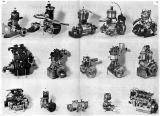
The Edgar T Westbury Tribute Pages have undergone a slight upgrade in the past month. When your webmaster finds that he can't easily locate something, this is taken as a sure sign that others will be in even worse trouble, hence the change. The page name that was previously the biography page is now an index to the other pages, including the biography, get it? So hopefully any links you may have bookmarked have not been broken—but will be when the site move is complete (now even I'm getting confused...) There is some new material on the index page, so it's worth a quick look. And while on the topic, a mail forum dedicated to ETW And ALL His Works has started on Yahoo. To join, goto
:
(actually, just click the link and go there, but you should know that...) The heading photo is a "centerfold" from an old MAP plans book and shows a one-time collection of Westbury designs. Alas, with the passing of the owner, Gerry Buck, the collection was sold and broken up in the process. Thanks go to Ken Croft for taking the time to scan the picture and thus prompt the much needed reorganization of the ETW pages.
British Maestros
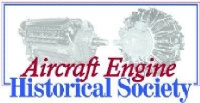
When outstanding achievements in operational, scale models of internal combustion aero engines are mentioned, two names immediately leap to my mind: Barry Hares and Brian Perkins (in no particular order). Regular readers of these pages should have no difficulty recalling their work. This is, respectively, modeling engines from Rolls Royce and Bristol. A query using the Site Search facility will find photos of their engines here, but it's well worth a trip to the Aero Engine Historical Society web site. AEHS president, Kimbal McCutcheon believes that these gentlemen and others building working scale replicas of full size engines are doing the best historical research work anywhere. In tribute, Kim has made available extensive photographs of their work on the AEHS web site. Including is a streaming video of Barry Hares' Merlin being started and put through its performance regime. Well worth a visit if you've not been there before.
Rare M&M's
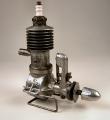
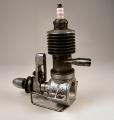
No, not the blue ones (or whatever that confectionary makers marketing division is hyping this month), rather a very good example of an unusual engine from the late 30's. This M&M pre-dates the Piston transfer valve M&M that was the first Motor Boy collaborative project back in 1997. The engine seen here, sans the tank and fuel metering assembly, was restored last month by Bert Striegler for its owner—who has the missing bits, but did not send them to Bert. Unlike its more well known sibling, this engine has a conventional (if hard to spot) bypass comprising a brazed-on cover arranged to be at the front of the engine after the cylinder is screwed home. Like the other M&M, the head is screwed into the cylinder (ie, it's not a 'blind' bore cylinder like others of the time).
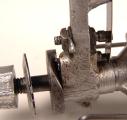 The point assembly seen here is also somewhat unusual—though perhaps not to students of ET Westbury's 1933 Atom Monor Mk III. The moving point is a flat spring pushing a lifter against the rear of the prop driver. This is cut away over the dwell period allowing the points to contact. Rotation of the assembly—a friction fit on a turned section of the crankcase—provides advance and retard of the spark. ETW's arrangement was similar, though "bent over" 90 degrees to make the spring lie horizontal.
The point assembly seen here is also somewhat unusual—though perhaps not to students of ET Westbury's 1933 Atom Monor Mk III. The moving point is a flat spring pushing a lifter against the rear of the prop driver. This is cut away over the dwell period allowing the points to contact. Rotation of the assembly—a friction fit on a turned section of the crankcase—provides advance and retard of the spark. ETW's arrangement was similar, though "bent over" 90 degrees to make the spring lie horizontal.
Texan Pepp
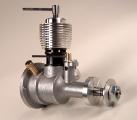
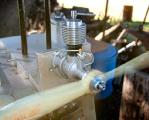
Bert's been busy this month. Here is the #3 Pepperell replica to reach the running stage. And showing that he has carefully read the Pepperell Book, Bert has made his engine more "authentic" than the previous examples by blacking the cylinder. While the Pepperells used heat for this process, Bert chose to apply a gun blueing chemical treatment that looks just great to me. Now I'll have to make a surreptitious visit to one of the local gun shops and see if they have such stuff downunder as the results are out standing. Like the other Pepps, Bert's engine starts easily and runs strongly. As Ken and I both found, the performance of this engine is remarkable, especially given the period of production (1946 onwards). It's unfortunate that very few of them made it outside their native New Zealand, as performance wise, they would have ranked at the top of their British contemperies (like the also overlooked American Vivell 09).
Help Stamp Out Gaskets
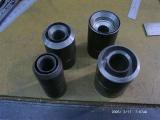

Bert's Pepp got us talking—yet again—of the ways we individually use to prpduce gaskets for our engines. This is a topic worthy of a Tech Tip in its own right, but I thought that these photos here from Eric Offen were too good to hang onto—or worse, get forgotten. I think they are self explanatory. For a few required gaskets, Eric turns them up fron whatever scraps of steel are on hand. The cutting edge as just as they leave the lathe—though he says that if they needed to produce more than just a few gaskets, they'd need case hardening. In use, the tool is placed over the gasket material (folded over multiple times to make several at once), and given a sharp whack. The backing needs to be hard-ish, but forgiving. Hope this gives you some ideas...
NGEZ1
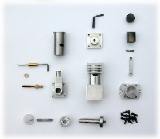
The Next Generation EZE that Joe Webster has been developing is now avaiable as one of the nicest plan sets I've seen in quite some time—since Todd Snouffer's LME-370 PIP, in fact. The plans are CAD (10 sheets), with 3D isometrics of the part included on each page, and a set of machining instructions (5 pages) aimed at the first-time engine builder. The price is so modest that it's obvious Joe in not planning on retiring on the proceeds any time soon. Have a look at his web site for A .056 Cubic Inch Compression Ignition Model Aircraft Engine. The site has a video of the engine being started, and a sound file of it screaming away happily. If you order a set of plans, be sure to tell 'im Ron sent 'ya.
The Slider Engine
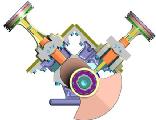
A nice email from Peter Raffaele at Slider Engine Technologies alerted me to this distant cousin of the Scotch-yoke; a theme that keeps popping up here for one reason or another. The Slider engineers have really progressed the concept of converting linear piston motion to rotary crankshaft motion with attention to minimizing piston side forces in a way that accommodates configurations other than the "flat" design inherent in engines like the Bourke. Peter says that Slider Tech is micro engine developer friendly and invites model engineers to drop them a line at [email protected]. I've added the Slider site to my list of unconventional engine technology web pages and will follow progress with interest.
Zimmerman Cirrus Progress
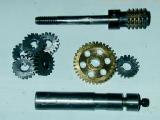
Since getting the "urge" last month to take the Zimmerman Cirrus project out from under the bench to demonstrate the Putting-on Tool, I've kept at it, making gears, camshafts (three!!) and performing jobs like line boring for the cam and crankshafts that take hours and hours to prepare for a job that's over in a minute. But the result is pleasing and I've been taking photos for what will become the Cirrus construction pages. Right now, it's photos only with minimal words (for which some will be thankful  ). The Cirrus is a non-trivial project, so we'll see how far I get this time before getting diverted to other things.
). The Cirrus is a non-trivial project, so we'll see how far I get this time before getting diverted to other things.
Kiwi Monosoupape
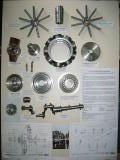
Right up there with the achievements of the British Maestros, in my humble opinion, is the work of Murray Lane in Auckland, New Zealand. Murray is one of those fortunate few who has been able to turn his hobby into a living, doing commercial model engineering, and accumulating a workshop to die for in the process. One of his personal projects for the past twelve years has been the creation of a scale working model of the now rare 18 cylinder Gnome Monosoupape ("one valve") rotary engine from World War I. The reason I rank Murry's work up there with the Rolls and Bristols is the degree of fidelity Murray is demanding of himself in the face of a dearth of information. This has forced him to conduct research far afield as the plans develop (currently 36 A3 pages, Murray reports).
In reaching the current stage, Murray has drawn on an original copy of the "Air Board Notes' (not the TEE reprint), and an assembled 9B engine that provided external measurements, along with a engine in bits on the South Island of New Zealand that provided more precise measurements of some internal parts. All of this underscores AEHS president, Kim Mc Cutcheon's assertion that model engineers are at the forefront of aircraft engine historical research. Murray is currently seeking:
- Any sort of end view of the double crank. A spare parts manual for a double row Gnome would probably help
- A photograph of the rear end of a double Gnome showing the position of the magnetos and pumps
Murray is also researching the Siemens-Halske Sh III rotary aero engine. If you can help, please drop me an email and I'll pass the information along. I'm sure I speak for all of us saying this is one engine I'd live to see finished and running.
New Books and Magazines This Month

The Model Engineers Workshop, Issue #104 which arrived this month is worth mentioning as it contains two articles on CNC adaptations of benchtop milling machines—the same machine actually—known in England as the "X3" (that's it on the cover). One article is part 3 of a series detailing how one owner converted the basic machine, replacing the leadscrews will ball-screws, and directly coupling them to stepper motors (ok, there's and Oldham coupling in between, but it's essentially direct). The other, shown on the cover, is a commercial/cottage CNC adaptation of the same machine that again uses ball-screws, but drives them via toothed belt reductions from the steppers. The former applies ball-screws to all three axis; the latter to the X-Y only, fitting the Z axis stepper to the "fine-feed" and leaving the column height a manual operation.
I mention this because I'm starting to think seriously about CNC in the home shop—and I confess, it's the prospect of milling all the rockers for the Cirrus that is the main driver for this. Figure this as a six month project with the shop pretty much off-line during that period and I start to vacillate. Still CNC is now being accepted and almost common in model engineering. The pioneer work as been done (try googling on "home shop CNC", or something like that) and the Early Adopters are on their second generation machines. Normally as an unreconstructed techo-weenie, I'd have been in that group, but too many other cool things to do have pushed me back to the Early Majority. We'll see.. first I have to get rid of that pile of junk I laughingly call a mill...
Engine Of The Month: Chunn Alternate Firing Twin
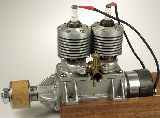
Once again, we've been saved at the twelfth hour from having no Engine of the Month by the unexpected arrival of photos for something that I've long felt deserved to be written up: the 1938 Alternate Firing Twin designed and manufactured by Bob Chunn. Our savior this month was Les Stone—although the photo above is the one built by Don McClusky which has been in the Engine Finder for quite some time as a photograph only. The extra shots from Les, together with material from The Library have enabled me to put together an in-depth description for the Chunn Twin. As usual, click on the link, the photo, or use the finder to view it.
Tech Tip of the Month: Machining Crankshafts
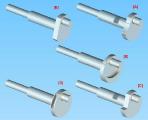
There are probably more ways of holding an overhung crankshaft to machine the crankpin than there are of inducing involuntary discorporation in cats. This was discussed exactly one year ago in this column of the March 2004 Model Engine News (how did I ever get by without the Site Search Facility?) As mentioned above, Bert Streigler has completed his Pepperell Seven-Sixteenths and followed up this glad news with pictures of his jigs and tooling. Bert and I think alike when it comes to holding the shaft while the pin is machined, but Bert has refined his process one step further than that which I now use. His set-up is so good, it forms the thrust of this month's Tech Tip, which includes the previous material, copied, revised and expanded to give some of the ways you might machine a standard model engine type overhung crankshaft. See the Techniques Index Page and follow the links.
ETA Booboo
And the disassembled, and somewhat disreputable ETA bones pictured last month, which is scheduled for restoration Real Soon Now, was of course, the second model, not the first—which as we all know, did not have "ETA" cast on the bypass (or at least, I know that now  ). The owner will be sad, but them's the breaks...
). The owner will be sad, but them's the breaks...
New Engine in the Finder
During February, someone on one of the Yahoo engine forums said they wanted to build a 60 sized glow motor as their first project and asked for recommendations. There are, to my knowledge, only a few such designs suitable for the first timer, so I recommended the Titan 60, giving a link to a photo of one on the web. The builder of the engine in the picture was lurking and kindly sent me a photo of his engine which has been added to the finder. Potential builders of this engine may like to check out back issues of Home Shop Machinist where the design first appeared, or ECJ where Roger Schroeder detailed his build of the engine. It does make a fair choice if you want a simple, large, glow motor (the other choice would be the "Jones 60" that appeared in the Model Engineer, although it ia TBR, ringed, R/C throttle equipped engine, so not precisely appropriate to a new-comer).
 Vale: Bob Palmer
Vale: Bob Palmer
 ETW Again
ETW Again
 British Maestros
British Maestros
 Rare M&M's
Rare M&M's
 Texan Pepp
Texan Pepp
 Help Stamp Out Gaskets
Help Stamp Out Gaskets
 The Slider Engine
The Slider Engine
 NGEZ1
NGEZ1
 Zimmerman Cirrus Progress
Zimmerman Cirrus Progress
 Kiwi Monosoupape
Kiwi Monosoupape
 ETA Booboo
ETA Booboo
 New Engine in the Finder
New Engine in the Finder
 Editorial
Editorial
 New Books and Magazines This Month
New Books and Magazines This Month
 Engine Of The Month: Chunn Alternate Firing Twin
Engine Of The Month: Chunn Alternate Firing Twin
 Tech Tip of the Month: Machining Crankshafts
Tech Tip of the Month: Machining Crankshafts
 Standard Stuff
Standard Stuff
 ). In two weeks time, it will be the big gliders turn (A2, or F1A if you will). These guys can go a long way quickly, but will tow easily in still air. Naturally, it will blow a gale and we'll walk miles with radio trackers to retrieve them...
). In two weeks time, it will be the big gliders turn (A2, or F1A if you will). These guys can go a long way quickly, but will tow easily in still air. Naturally, it will blow a gale and we'll walk miles with radio trackers to retrieve them...














